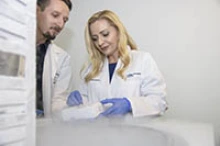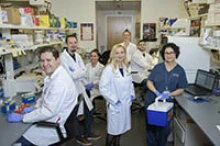Potential Target to Diagnose, Monitor Cervical Cancer Treatment Aim of UArizona Health Sciences Researchers
Dr. Melissa Herbst-Kralovetz’s research team found proteins called immune checkpoint inhibitors in the cervicovaginal environment that may help predict if a woman suffers from abnormal cell growth or cancer.
TUCSON, Ariz. – University of Arizona Health Sciences researchers’ quest to better understand the vaginal microbiome and its role in human papillomavirus (HPV) infection, which may progress into cervical cancer, has revealed potential new targets for early detection and monitoring treatment – proteins known as immune checkpoints.

Drs. Melissa Herbst-Kralovetz and Paweł Łaniewski select cells preserved through cryopreservation, a technique that can freeze cells without damaging them. (Photo: Kris Hanning/University of Arizona Health Sciences)
Immune checkpoints regulate a patient’s immune system and can dictate recognition and elimination of cancer cells. Presence and implications of these proteins in the cervicovaginal environment, however, had previously not been studied, said Melissa Herbst-Kralovetz, PhD, associate professor of basic medical sciences and obstetrics/gynecology at the UArizona College of Medicine – Phoenix, and director of the Women’s Health Research Program, as well as a member of the UArizona Cancer Center.
Dr. Herbst-Kralovetz and researchers in her lab continue to untangle the complexities of the vaginal microbiome, seeking to harness the microbiome or other features of the microenvironment to better detect, prevent and treat gynecologic cancers, such as cervical cancer, which can be caused by HPV infection. Their previous investigations have uncovered several potential molecular signals, or indicators, of cancer (known as biomarkers). This led Dr. Herbst-Kralovetz and co-investigator Paweł Łaniewski, PhD, to wonder if immune checkpoints also could be detected at this site because these proteins play a key role in attacking or eliminating cancer cells.
“We know immune checkpoint proteins often are overexpressed in the tumor microenvironment, meaning they are increased, which can promote carcinogenesis (cancer development) by not allowing for an effective anti-tumor response,” Dr. Herbst-Kralovetz said. “So we hypothesized these checkpoints also may be at work in the cervicovaginal microenvironment and may be altered with HPV infection, precancer and cancer.”

Melissa Herbst-Kralovetz, PhD, with her research team inside the lab at the Phoenix Biomedical Campus. (Photo: Kris Hanning/University of Arizona Health Sciences)
In a new study published in August in npj Precision Oncology, a journal of the Nature Publishing Group, and referenced in Nature’s “Behind the Paper” blog, Drs. Herbst-Kralovetz and Laniewski discuss their research in collaboration with colleagues from the UArizona Biostatistics Shared Resource, including Denise Roe, DrPH, resource director; Haiyan Cui, PhD, senior research specialist, UArizona Cancer Center; and Dana Chase, MD, a clinical collaborator from Arizona Oncology.
Using cervicovaginal lavages (CVLs), a non-invasive method to collect fluid samples from a patient, the researchers were able to measure the immune checkpoint proteins in the cervicovaginal environment. As a result, they discovered these proteins have the potential to predict whether a woman has dysplasia – abnormal cell growth – or cancer.
“We identified immune checkpoints that specifically and sensitively discriminated cancer patients from healthy women or women with dysplasia,” said Dr. Łaniewski, referring to abnormal cell growth on the lining of the cervix or endocervical canal – the pathway from inside the uterus to the vagina. “Intriguingly, we also found that women with genital inflammation, or unhealthy vaginal bacteria, also have elevated specific immune checkpoints, suggesting these features of the local microenvironment also might contribute to cancer progression.”

Melissa Herbst-Kralovetz, PhD, examines vaginal bacteria in her lab. Her work might someday help prevent, predict or treat cervical cancer, endometrial cancer and ovarian cancer. (Photo: Kris Hanning/University of Arizona Health Sciences)
“In addition to the promising evidence that reveals new biomarkers, this study highlights the potential utility of CVL profiling for predicting and monitoring response to therapy,” Dr. Herbst-Kralovetz said. “For the individual, a CVL is minimally invasive and even easier than a blood draw. This also could evolve into a self-collected sample, like a swab.”
These findings, combined with previous and other ongoing studies, provide a foundation for future studies for Dr. Herbst-Kralovetz and her research team. They intend to further study immune checkpoints to determine if, in addition to being a tool for early detection, they can be used to monitor and predict responses to cancer therapy.
“I’m incredibly passionate about creating interdisciplinary research teams to build our understanding of gynecologic cancers and the local microenvironment to positively impact women’s health outcomes,” Dr. Herbst-Kralovetz said. “This is a first step for precision medicine approaches for novel diagnostics, and it also may be a way for us to track how patients are responding to treatment.”
# # #
A related story and photo gallery associated with this article can be found on the UArizona Health Sciences website.
NOTE: Photos available here – https://arizona.box.com/s/eamuzz3jrcddz5kwxxw9mypjzx4afny0.
About the University of Arizona Cancer Center
The University of Arizona Cancer Center is the only National Cancer Institute-designated Comprehensive Cancer Center with headquarters in Arizona. The UArizona Cancer Center is supported by NCI Cancer Center Support Grant No. CA023074. With primary locations at the University of Arizona in Tucson and at Dignity Health St. Joseph’s Hospital and Medical Center in Phoenix, the Arizona Cancer Center has more than a dozen research and education offices throughout the state, with more than 300 physicians and scientists working together to prevent and cure cancer. For more information: cancercenter.arizona.edu (Follow us: YouTube).
About the UArizona College of Medicine – Phoenix
Founded in 2007, the University of Arizona College of Medicine – Phoenix inspires and trains exemplary physicians, scientists and leaders to optimize health and health care in Arizona and beyond. By cultivating collaborative research locally and globally, the college accelerates discovery in a number of critical areas — including cancer, stroke, traumatic brain injury and cardiovascular disease. Championed as a student-centric campus, the college has graduated 500 physicians, all of whom received exceptional training from nine clinical partners and 1,800 diverse faculty members. As the anchor to the Phoenix Biomedical Campus, which is projected to have an economic impact of $3.1 billion by 2025, the college prides itself on engaging with the community, fostering education, inclusion, access and advocacy. For more information, please visit phoenixmed.arizona.edu (Follow us: Facebook | Twitter | YouTube | LinkedIn | Instagram).
About the University of Arizona Health Sciences
The University of Arizona Health Sciences is the statewide leader in biomedical research and health professions training. UArizona Health Sciences includes the Colleges of Medicine (Tucson and Phoenix), Nursing, Pharmacy, and the Mel and Enid Zuckerman College of Public Health, with main campus locations in Tucson and the Phoenix Biomedical Campus in downtown Phoenix. From these vantage points, Health Sciences reaches across the state of Arizona, the greater Southwest and around the world to provide next-generation education, research and outreach. A major economic engine, Health Sciences employs nearly 5,000 people, has approximately 4,000 students and 900 faculty members, and garners $200 million in research grants and contracts annually. For more information: uahs.arizona.edu (Follow us: Facebook | Twitter | YouTube | LinkedIn | Instagram).

